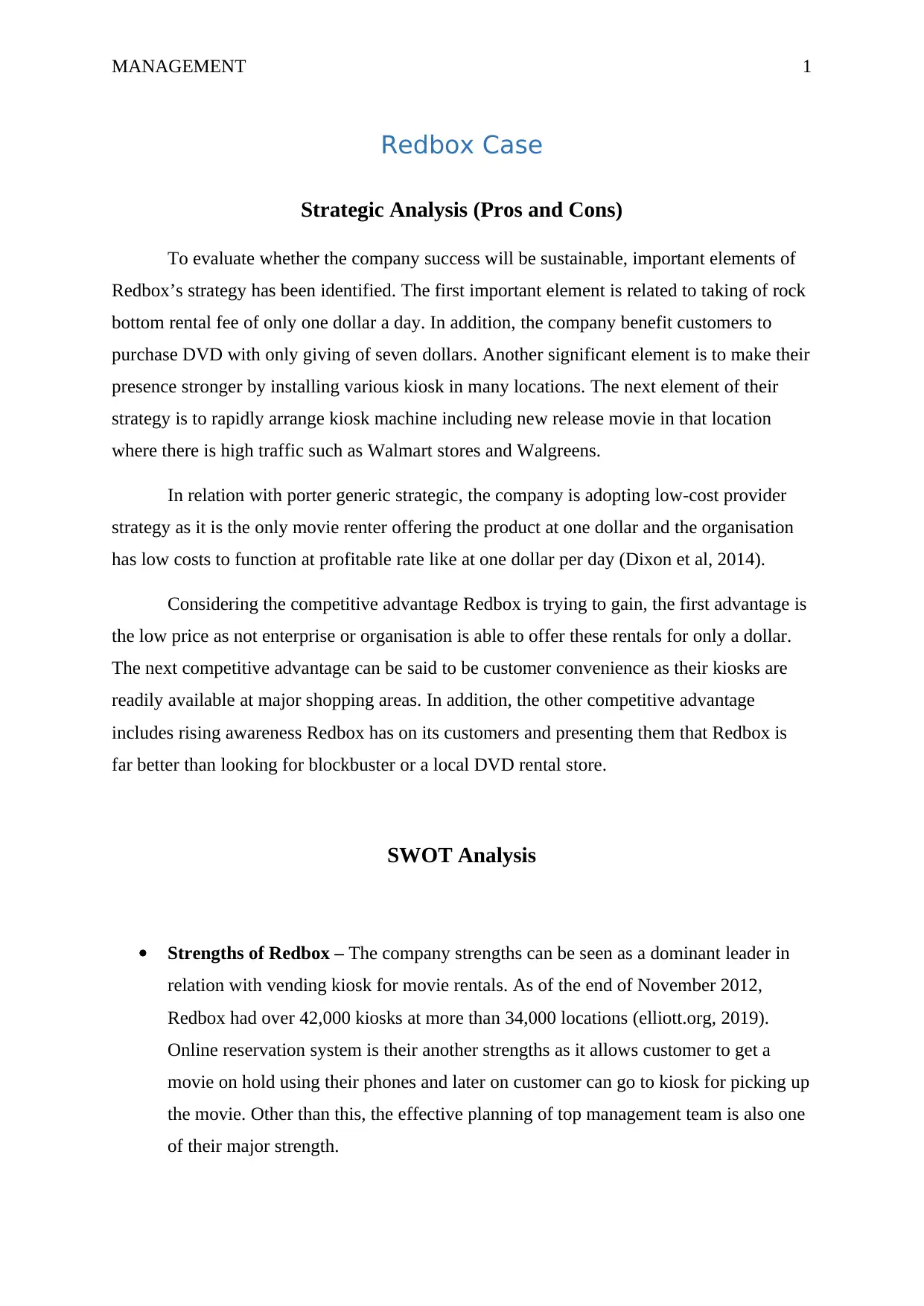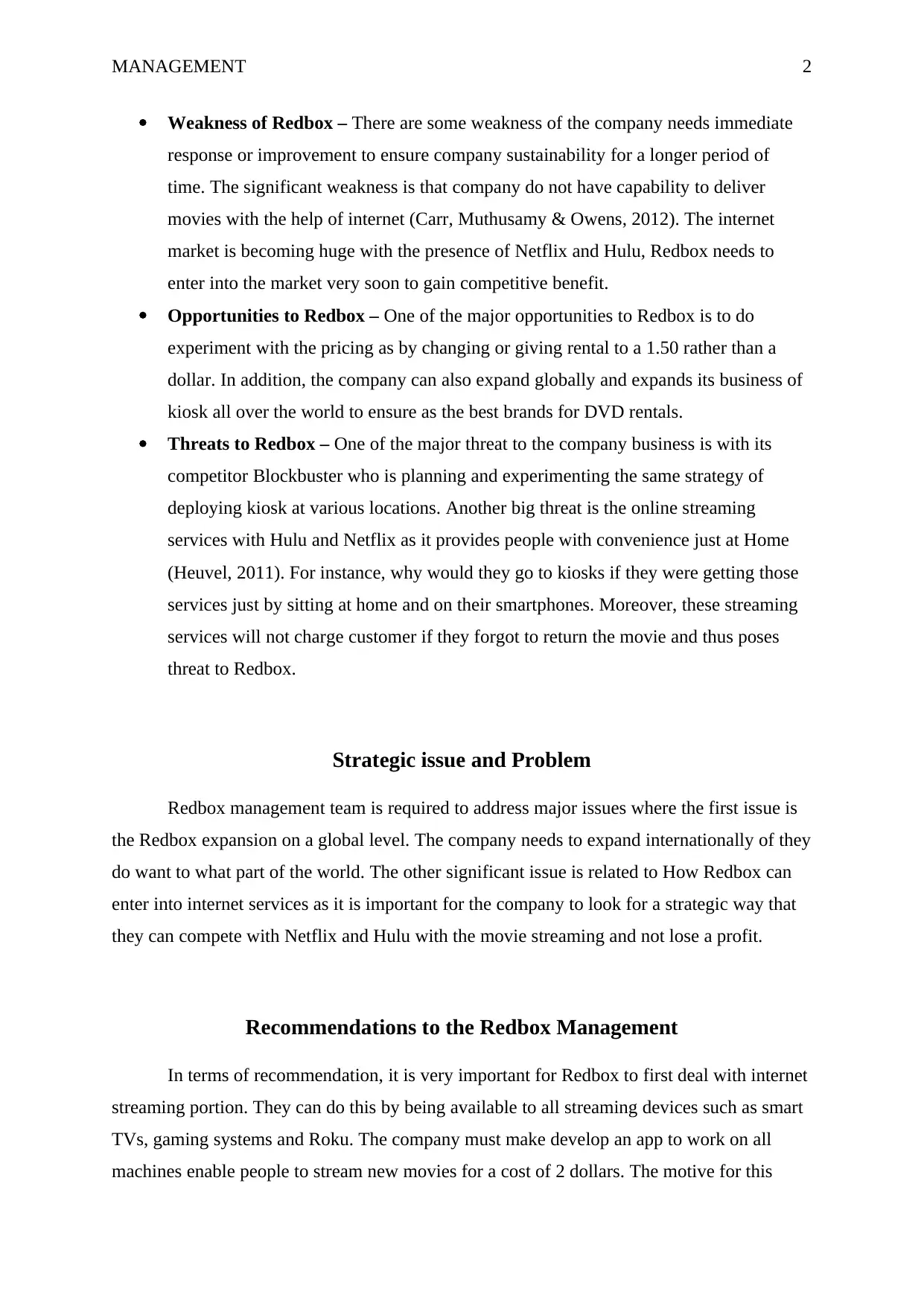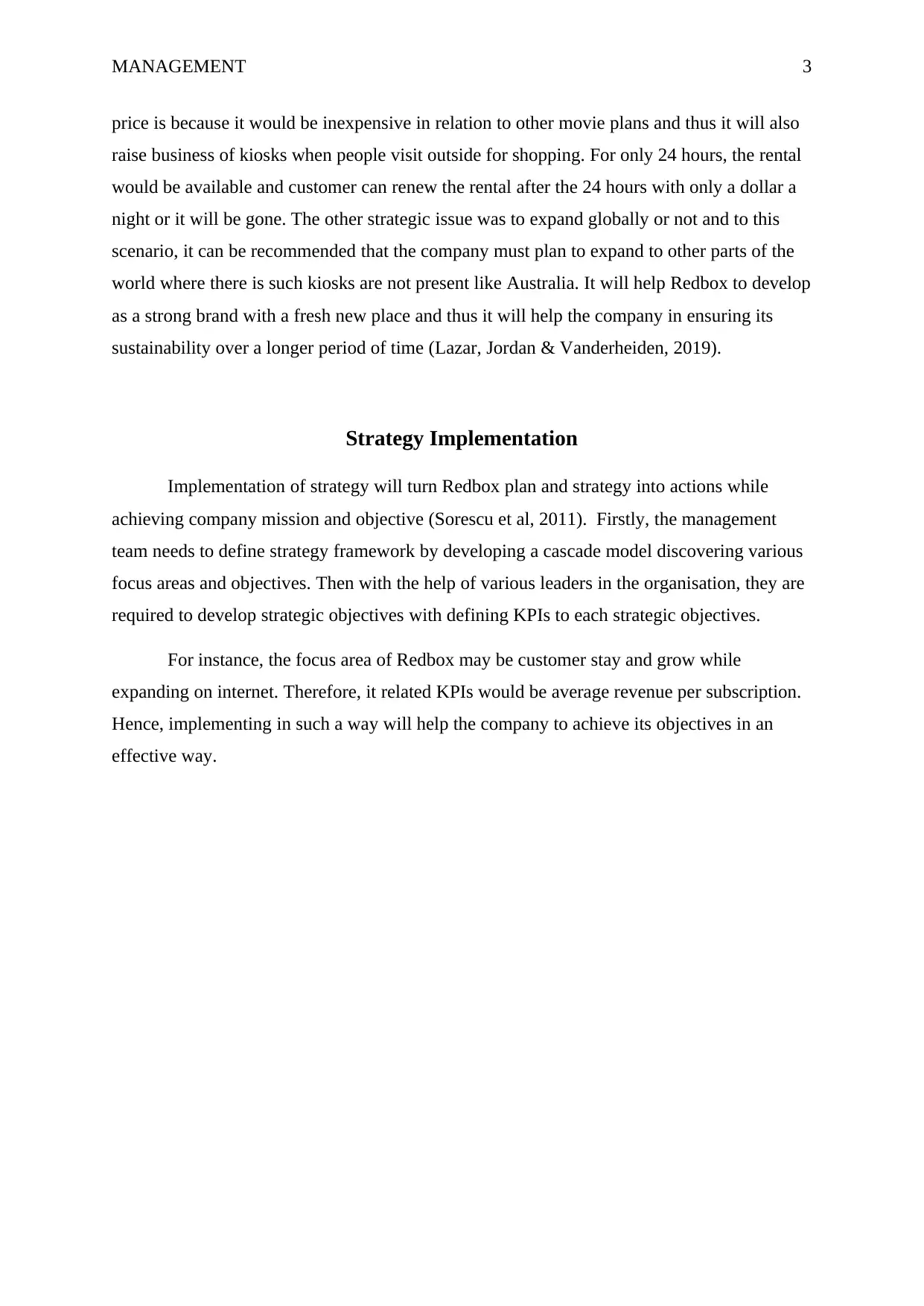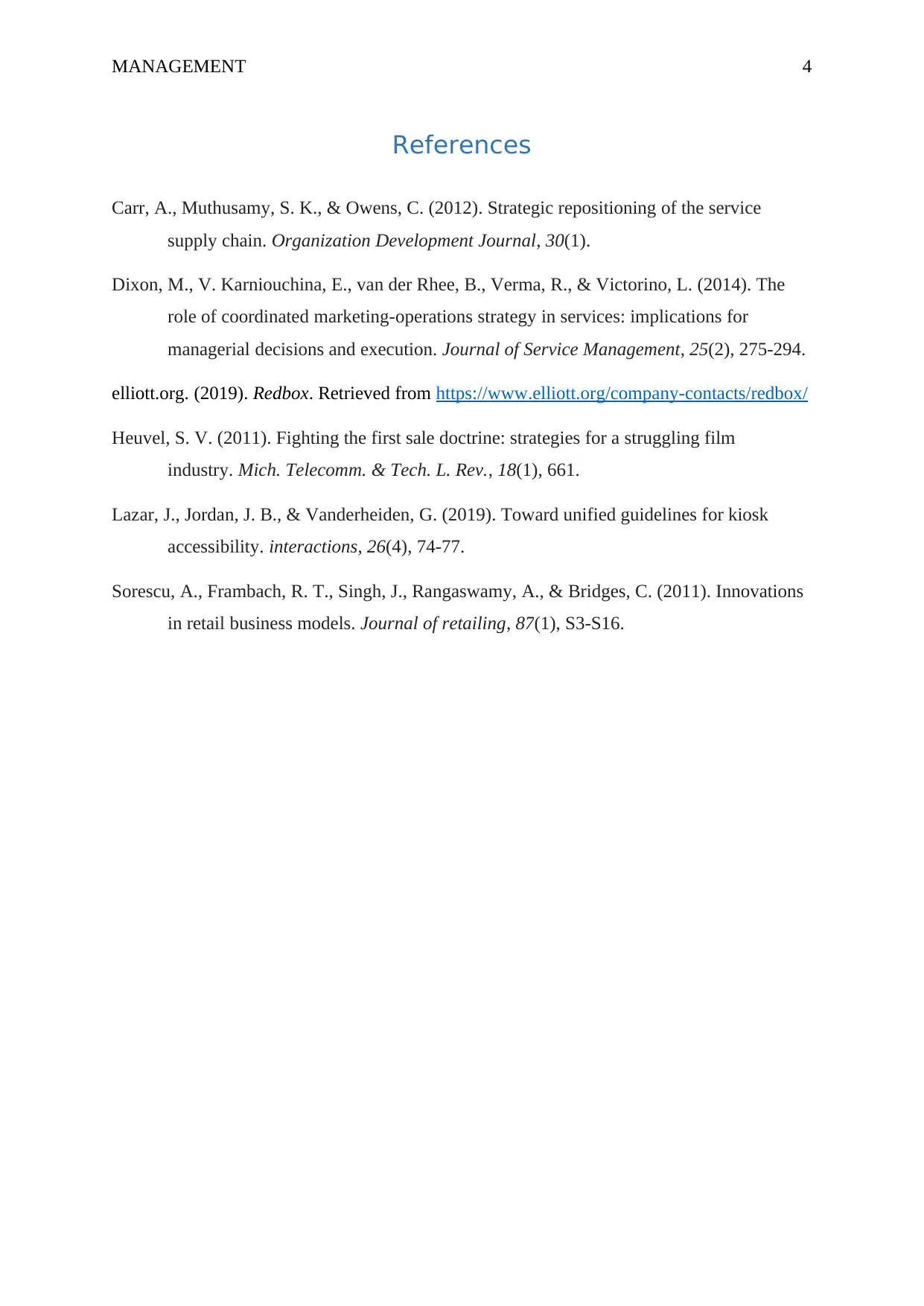MGMT 301: International Marketing Strategy - Redbox Case Analysis
VerifiedAdded on 2022/11/13
|5
|1273
|207
Report
AI Summary
This report provides a strategic analysis of Redbox's international marketing strategy, focusing on its low-cost provider approach and kiosk-based rental model. The analysis covers Redbox's strengths, such as its dominant market presence and online reservation system, and weaknesses, particularly its lack of internet streaming capabilities. Opportunities for expansion, including global market entry and pricing adjustments, are discussed, alongside threats from competitors like Blockbuster and online streaming services like Netflix and Hulu. The report presents a SWOT analysis, identifies strategic issues such as global expansion and entering the internet services market, and offers recommendations. Key recommendations include developing a streaming service compatible with various devices and expanding into new international markets like Australia. Finally, the report addresses strategy implementation, emphasizing the need for a defined strategy framework and key performance indicators (KPIs) to achieve company objectives.

Running Head: MANAGEMENT 0
INTERNATIONAL
MARKETING STRATEGY
INTERNATIONAL
MARKETING STRATEGY
Paraphrase This Document
Need a fresh take? Get an instant paraphrase of this document with our AI Paraphraser

MANAGEMENT 1
Redbox Case
Strategic Analysis (Pros and Cons)
To evaluate whether the company success will be sustainable, important elements of
Redbox’s strategy has been identified. The first important element is related to taking of rock
bottom rental fee of only one dollar a day. In addition, the company benefit customers to
purchase DVD with only giving of seven dollars. Another significant element is to make their
presence stronger by installing various kiosk in many locations. The next element of their
strategy is to rapidly arrange kiosk machine including new release movie in that location
where there is high traffic such as Walmart stores and Walgreens.
In relation with porter generic strategic, the company is adopting low-cost provider
strategy as it is the only movie renter offering the product at one dollar and the organisation
has low costs to function at profitable rate like at one dollar per day (Dixon et al, 2014).
Considering the competitive advantage Redbox is trying to gain, the first advantage is
the low price as not enterprise or organisation is able to offer these rentals for only a dollar.
The next competitive advantage can be said to be customer convenience as their kiosks are
readily available at major shopping areas. In addition, the other competitive advantage
includes rising awareness Redbox has on its customers and presenting them that Redbox is
far better than looking for blockbuster or a local DVD rental store.
SWOT Analysis
Strengths of Redbox – The company strengths can be seen as a dominant leader in
relation with vending kiosk for movie rentals. As of the end of November 2012,
Redbox had over 42,000 kiosks at more than 34,000 locations (elliott.org, 2019).
Online reservation system is their another strengths as it allows customer to get a
movie on hold using their phones and later on customer can go to kiosk for picking up
the movie. Other than this, the effective planning of top management team is also one
of their major strength.
Redbox Case
Strategic Analysis (Pros and Cons)
To evaluate whether the company success will be sustainable, important elements of
Redbox’s strategy has been identified. The first important element is related to taking of rock
bottom rental fee of only one dollar a day. In addition, the company benefit customers to
purchase DVD with only giving of seven dollars. Another significant element is to make their
presence stronger by installing various kiosk in many locations. The next element of their
strategy is to rapidly arrange kiosk machine including new release movie in that location
where there is high traffic such as Walmart stores and Walgreens.
In relation with porter generic strategic, the company is adopting low-cost provider
strategy as it is the only movie renter offering the product at one dollar and the organisation
has low costs to function at profitable rate like at one dollar per day (Dixon et al, 2014).
Considering the competitive advantage Redbox is trying to gain, the first advantage is
the low price as not enterprise or organisation is able to offer these rentals for only a dollar.
The next competitive advantage can be said to be customer convenience as their kiosks are
readily available at major shopping areas. In addition, the other competitive advantage
includes rising awareness Redbox has on its customers and presenting them that Redbox is
far better than looking for blockbuster or a local DVD rental store.
SWOT Analysis
Strengths of Redbox – The company strengths can be seen as a dominant leader in
relation with vending kiosk for movie rentals. As of the end of November 2012,
Redbox had over 42,000 kiosks at more than 34,000 locations (elliott.org, 2019).
Online reservation system is their another strengths as it allows customer to get a
movie on hold using their phones and later on customer can go to kiosk for picking up
the movie. Other than this, the effective planning of top management team is also one
of their major strength.

MANAGEMENT 2
Weakness of Redbox – There are some weakness of the company needs immediate
response or improvement to ensure company sustainability for a longer period of
time. The significant weakness is that company do not have capability to deliver
movies with the help of internet (Carr, Muthusamy & Owens, 2012). The internet
market is becoming huge with the presence of Netflix and Hulu, Redbox needs to
enter into the market very soon to gain competitive benefit.
Opportunities to Redbox – One of the major opportunities to Redbox is to do
experiment with the pricing as by changing or giving rental to a 1.50 rather than a
dollar. In addition, the company can also expand globally and expands its business of
kiosk all over the world to ensure as the best brands for DVD rentals.
Threats to Redbox – One of the major threat to the company business is with its
competitor Blockbuster who is planning and experimenting the same strategy of
deploying kiosk at various locations. Another big threat is the online streaming
services with Hulu and Netflix as it provides people with convenience just at Home
(Heuvel, 2011). For instance, why would they go to kiosks if they were getting those
services just by sitting at home and on their smartphones. Moreover, these streaming
services will not charge customer if they forgot to return the movie and thus poses
threat to Redbox.
Strategic issue and Problem
Redbox management team is required to address major issues where the first issue is
the Redbox expansion on a global level. The company needs to expand internationally of they
do want to what part of the world. The other significant issue is related to How Redbox can
enter into internet services as it is important for the company to look for a strategic way that
they can compete with Netflix and Hulu with the movie streaming and not lose a profit.
Recommendations to the Redbox Management
In terms of recommendation, it is very important for Redbox to first deal with internet
streaming portion. They can do this by being available to all streaming devices such as smart
TVs, gaming systems and Roku. The company must make develop an app to work on all
machines enable people to stream new movies for a cost of 2 dollars. The motive for this
Weakness of Redbox – There are some weakness of the company needs immediate
response or improvement to ensure company sustainability for a longer period of
time. The significant weakness is that company do not have capability to deliver
movies with the help of internet (Carr, Muthusamy & Owens, 2012). The internet
market is becoming huge with the presence of Netflix and Hulu, Redbox needs to
enter into the market very soon to gain competitive benefit.
Opportunities to Redbox – One of the major opportunities to Redbox is to do
experiment with the pricing as by changing or giving rental to a 1.50 rather than a
dollar. In addition, the company can also expand globally and expands its business of
kiosk all over the world to ensure as the best brands for DVD rentals.
Threats to Redbox – One of the major threat to the company business is with its
competitor Blockbuster who is planning and experimenting the same strategy of
deploying kiosk at various locations. Another big threat is the online streaming
services with Hulu and Netflix as it provides people with convenience just at Home
(Heuvel, 2011). For instance, why would they go to kiosks if they were getting those
services just by sitting at home and on their smartphones. Moreover, these streaming
services will not charge customer if they forgot to return the movie and thus poses
threat to Redbox.
Strategic issue and Problem
Redbox management team is required to address major issues where the first issue is
the Redbox expansion on a global level. The company needs to expand internationally of they
do want to what part of the world. The other significant issue is related to How Redbox can
enter into internet services as it is important for the company to look for a strategic way that
they can compete with Netflix and Hulu with the movie streaming and not lose a profit.
Recommendations to the Redbox Management
In terms of recommendation, it is very important for Redbox to first deal with internet
streaming portion. They can do this by being available to all streaming devices such as smart
TVs, gaming systems and Roku. The company must make develop an app to work on all
machines enable people to stream new movies for a cost of 2 dollars. The motive for this
⊘ This is a preview!⊘
Do you want full access?
Subscribe today to unlock all pages.

Trusted by 1+ million students worldwide

MANAGEMENT 3
price is because it would be inexpensive in relation to other movie plans and thus it will also
raise business of kiosks when people visit outside for shopping. For only 24 hours, the rental
would be available and customer can renew the rental after the 24 hours with only a dollar a
night or it will be gone. The other strategic issue was to expand globally or not and to this
scenario, it can be recommended that the company must plan to expand to other parts of the
world where there is such kiosks are not present like Australia. It will help Redbox to develop
as a strong brand with a fresh new place and thus it will help the company in ensuring its
sustainability over a longer period of time (Lazar, Jordan & Vanderheiden, 2019).
Strategy Implementation
Implementation of strategy will turn Redbox plan and strategy into actions while
achieving company mission and objective (Sorescu et al, 2011). Firstly, the management
team needs to define strategy framework by developing a cascade model discovering various
focus areas and objectives. Then with the help of various leaders in the organisation, they are
required to develop strategic objectives with defining KPIs to each strategic objectives.
For instance, the focus area of Redbox may be customer stay and grow while
expanding on internet. Therefore, it related KPIs would be average revenue per subscription.
Hence, implementing in such a way will help the company to achieve its objectives in an
effective way.
price is because it would be inexpensive in relation to other movie plans and thus it will also
raise business of kiosks when people visit outside for shopping. For only 24 hours, the rental
would be available and customer can renew the rental after the 24 hours with only a dollar a
night or it will be gone. The other strategic issue was to expand globally or not and to this
scenario, it can be recommended that the company must plan to expand to other parts of the
world where there is such kiosks are not present like Australia. It will help Redbox to develop
as a strong brand with a fresh new place and thus it will help the company in ensuring its
sustainability over a longer period of time (Lazar, Jordan & Vanderheiden, 2019).
Strategy Implementation
Implementation of strategy will turn Redbox plan and strategy into actions while
achieving company mission and objective (Sorescu et al, 2011). Firstly, the management
team needs to define strategy framework by developing a cascade model discovering various
focus areas and objectives. Then with the help of various leaders in the organisation, they are
required to develop strategic objectives with defining KPIs to each strategic objectives.
For instance, the focus area of Redbox may be customer stay and grow while
expanding on internet. Therefore, it related KPIs would be average revenue per subscription.
Hence, implementing in such a way will help the company to achieve its objectives in an
effective way.
Paraphrase This Document
Need a fresh take? Get an instant paraphrase of this document with our AI Paraphraser

MANAGEMENT 4
References
Carr, A., Muthusamy, S. K., & Owens, C. (2012). Strategic repositioning of the service
supply chain. Organization Development Journal, 30(1).
Dixon, M., V. Karniouchina, E., van der Rhee, B., Verma, R., & Victorino, L. (2014). The
role of coordinated marketing-operations strategy in services: implications for
managerial decisions and execution. Journal of Service Management, 25(2), 275-294.
elliott.org. (2019). Redbox. Retrieved from https://www.elliott.org/company-contacts/redbox/
Heuvel, S. V. (2011). Fighting the first sale doctrine: strategies for a struggling film
industry. Mich. Telecomm. & Tech. L. Rev., 18(1), 661.
Lazar, J., Jordan, J. B., & Vanderheiden, G. (2019). Toward unified guidelines for kiosk
accessibility. interactions, 26(4), 74-77.
Sorescu, A., Frambach, R. T., Singh, J., Rangaswamy, A., & Bridges, C. (2011). Innovations
in retail business models. Journal of retailing, 87(1), S3-S16.
References
Carr, A., Muthusamy, S. K., & Owens, C. (2012). Strategic repositioning of the service
supply chain. Organization Development Journal, 30(1).
Dixon, M., V. Karniouchina, E., van der Rhee, B., Verma, R., & Victorino, L. (2014). The
role of coordinated marketing-operations strategy in services: implications for
managerial decisions and execution. Journal of Service Management, 25(2), 275-294.
elliott.org. (2019). Redbox. Retrieved from https://www.elliott.org/company-contacts/redbox/
Heuvel, S. V. (2011). Fighting the first sale doctrine: strategies for a struggling film
industry. Mich. Telecomm. & Tech. L. Rev., 18(1), 661.
Lazar, J., Jordan, J. B., & Vanderheiden, G. (2019). Toward unified guidelines for kiosk
accessibility. interactions, 26(4), 74-77.
Sorescu, A., Frambach, R. T., Singh, J., Rangaswamy, A., & Bridges, C. (2011). Innovations
in retail business models. Journal of retailing, 87(1), S3-S16.
1 out of 5
Related Documents
Your All-in-One AI-Powered Toolkit for Academic Success.
+13062052269
info@desklib.com
Available 24*7 on WhatsApp / Email
![[object Object]](/_next/static/media/star-bottom.7253800d.svg)
Unlock your academic potential
Copyright © 2020–2025 A2Z Services. All Rights Reserved. Developed and managed by ZUCOL.



